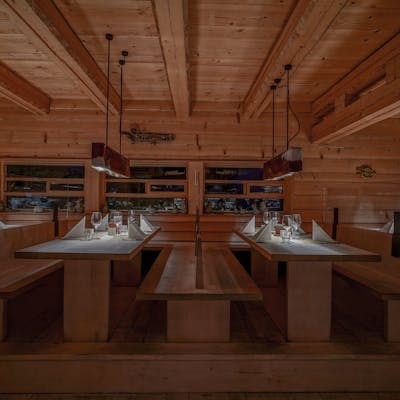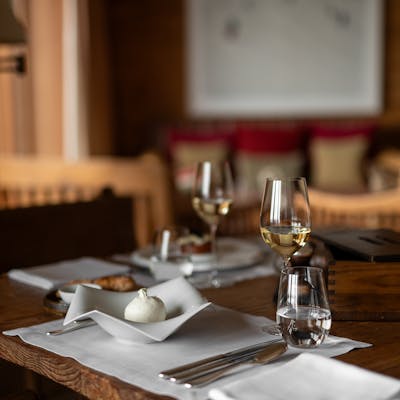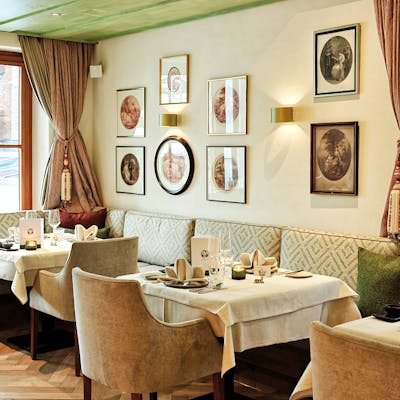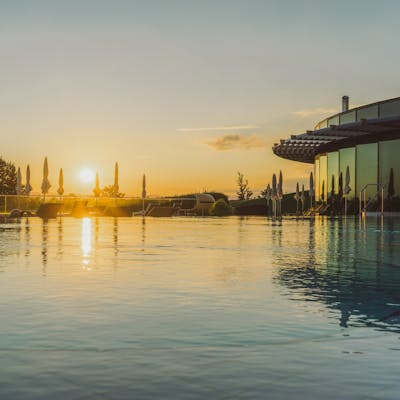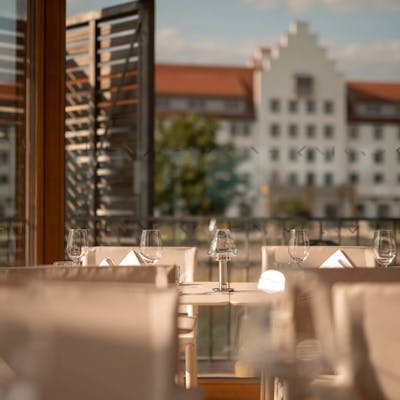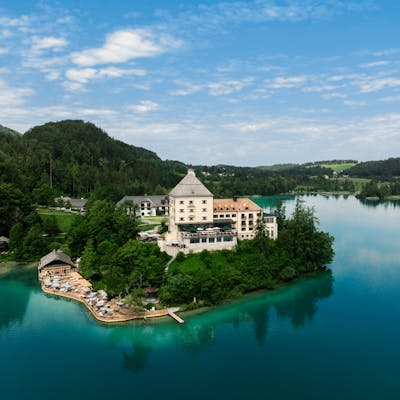
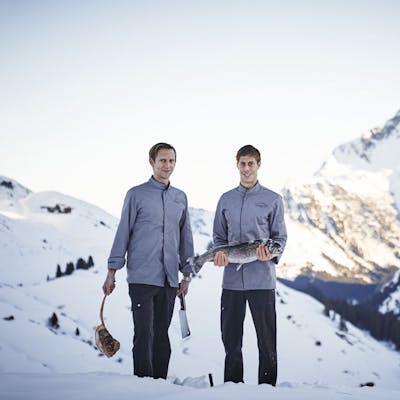
A visual highlight
When excellent regional cuisine explodes with creativity and flavours


Each course is a small work of art, presented like a painting. And each bite is a delicious interplay of different aromas. Chefs de cuisine Christian Rescher and Markus Niederwanger regularly produce culinary gourmet fireworks at the award-winning gourmet restaurant of Hotel Aurelio in Lech. Arlberg cuisine at its best! The dream team of Natural Art Cuisine not only knows how to stylishly deconstruct itself and create new things; it also knows how to have a good conversation and share its knowledge. During their cooking classes participants get to observe, wonder, create, and – of course – enjoy every bite of the result!
L.L./ Before we begin: Do you have some sort of motivating morning ritual that gets you going every day? Or, in other words: do you have a secret breakfast recipe that lets you start your day bursting with energy?
C.R./ Of the two of us it’s more Markus who has breakfast whereas I am happy with two cups of coffee in the morning. In the case of our guests it very much depends on where they’re from. Holidaymakers from Russia prefer eggs benedict or overnight oats. It really varies quite a lot and I wouldn’t say there’s a definite favourite.
M.N./ No morning ritual per se, but I do like eating classic bread rolls, especially in winter. During the summer months I don’t really have breakfast and I think I’m not the only one. Our breakfast menu also changes with the seasons. During winter people need more energy in the mornings, which makes all kinds of cereal more popular.
The development happened automatically when that shift towards regional cuisine took place.
L.L./ Your culinary journey leads from the province of Salzburg via Innsbruck to Lech and the gourmet restaurant & hotel Aurelio. How have your sense of taste and passion for cooking developed in the past years?
C.R./ A development happened automatically when that shift towards regional cuisine took place. It’s important to focus on the topic of Austria. Newly interpreting traditional dishes and embedding them in the gourmet menu. Straightforward things like “Bauernkrapfen” (a rustic type of doughnut) or “Schneenockerl” (a fluffy dessert made from whipped egg whites) that are guaranteed to bring back childhood memories are based on the simplest and, simultaneously, best ingredients from the region. When I was still an apprentice, dishes with lobster, crayfish, and snails were all the rage. I’ve been at Aurelio for eleven years now. In the first two years we needed to find our groove with the house and the guests. After that we started adapting the menu. We had pigeon and goose liver in the beginning, but then the producers started approaching us with suggestions like fresh chicken. A gourmet menu without filet used to be unthinkable; today chicken breast is a recommendation on our menu.
M.N./ My journey was not quite as straightforward as Christian’s. I was a lateral entrant, if you will. Initially I’d wanted to study, which did not pan out, unfortunately. And when I was in my mid-20s I went to the tourism college in Innsbruck and somehow, by chance, landed in the kitchen. I used to enjoy cooking with my mum, but it was never my plan A to become a chef. Then, about six months into my training, I met Christian and we cooked together twice in Innsbruck. In the meantime I’d also gotten jobs with Babylon and Sitzwohl in Innsbruck. And then, one day, Christian calls me and asks how I’d feel about a relaxed season on Arlberg, with lots of snowboarding. Even if nothing came of the snowboarding idea it was still worth it.

Newly interpreting traditional dishes and embedding them in the gourmet menu.
L.L./ Nature often inspires art and literature. You describe your cooking style as “Natural Art Cuisine”. How much art is there in your cooking?
C.R./ Excellent question. It depends on what art means to you. It is quite possible to make dishes look like works of art. Not for nothing do we say something is a feast for the eyes. Our signature dish is a good example; our “Wald & Wiese” (woods & meadows) classic – a mushroom made from white chocolate, refined with an infusion of hand-picked porcino mushrooms and served with moss, soil, dried flowers and fresh yarrow, just like it would occur in nature. We like making dishes that are proper works of art. And in terms of taste we are artsy, too, because we only serve the original, proper taste of regional products.
M.N./ There are many chefs who can put together three things in a bowl. But for us the visual aspect is extremely important, too. Still, taste naturally plays a vital role – if not the lead role! About three years ago we made a dish that was entirely made of carrot, where “all” we did was refine the ingredients.
This goes to show that things don’t always work out the way we imagine them in our heads.
L.L./ How long does it take you to develop a new dish? What does the process look like?
C.R./ New dishes can be created in a single day or over the course of years. Experiment and see. There are quite a few producers here who have become good friends of ours. We like to talk to them in private and see what ideas for new dishes they might have. A few years ago, we wanted to try and put poulet noir on the menu. A complete disaster that cost us quite a bit of money, too. The animals simply don’t thrive in our region, there was little meat on them, and it was quite stringy. This goes to show that things don’t always work out the way we imagine them in our heads.
M.N./ The thing with the poulet noir was such a lengthy project because the animals were growing so slowly. An experiment that definitely went awry. Generally, however, it’s normal to keep trying things out until there’s harmony on the plate. And that can only happen with teamwork. Each person in the kitchen gets to voice their opinions, suggestions, and ideas.
Wordrap with Christian Rescher and Markus Niederwanger
In the kitchen I like to hear…
C.R. / good music. M.N. / a happy “Yes, chef!”.
The taste of … reminds me of home.
C.R. / Porcini mushrooms. M.N. / Speckknödel (bacon dumplings).
In Lech Zürs I learned to…
C.R. / think regionally. M.N. / … and freeride, too.
When I’m not cooking …
C.R. / I’m cooking at home or I’m out in the woods. M.N.. / I’m on the slopes.
L.L./ I, personally, am already in love with your signature dish “Wald & Wiese”. How do you create this magic on a plate without confusing the eater?
C.R./ We worked on the signature dish, a dessert, throughout the summer months. That’s when we tend to be less busy and can dedicate our time to this particular part of our cuisine. My teacher always used to say that a meal has to be convincing from the first to the last course.
M.N./ This would be an example of a dish that took two years to perfect. Each time a small thing was added or changed. And that’s exactly what we want for our guests. It’s supposed to be a surprise that enchants the senses.

It’s normal for us to keep trying things out until there’s harmony on the plate.
L.L./ Since the rise of televised cooking shows an arms race has broken out in private kitchens. Which five things are really essential for good cooking at home?
C.R./ To begin with a good stove and oven. Plus proper tools and knowing how to use them.
M.N./ Though, at the same time, it might not be the devices that play a crucial role here, but rather the time you invest in cooking. Plenty of time usually yields good results.

L.L./ You don’t just create delicious meals at Aurelio, you also share your know-how during cooking classes. How can we picture your cooking classes?
C.R./ We usually only host the course during the summer, at the Aurelio Clubhaus Chalet. The Chalet has a large kitchen for eight or nine people where it’s easy to stand together in a group and make sure everyone has a good view. And then there are two options: either we – that is one or both of us – cook a three-course meal made up of small bites that is enjoyed in the end just like we would do when we cook and serve something at home. The idea for the choice of courses comes from our menu from the beginning of the year. Not necessarily super complicated gourmet meals but rather simple things that are easy to replicate. The second option: we cook the first course, and the guests sit down and eat in peace. Only after that do we proceed to serving the second course together and so on and so forth.
M.N./ Our course participants get all the recipes to take home with them. Many of the guests don’t want to actively cook but prefer to watch and maybe stick a toe in the water. After the first steps it usually becomes clear quickly who wants to participate to what extent.
My teacher always used to say that a meal has to be convincing from the first all the way to the last course.
L.L./ If we wanted to cook one of your dishes at home: what would we need?
C.R./ It’s impossible to generalise like that. There is no universal manual, only specific devices for different dishes. In many cases it is possible to improvise at home and use a Thermomix or a different kind of food processor. What I also have at home, for example, is a hand-held blender, a potato press, a good peeler or a cast-iron skillet. Which I got from Markus for my birthday, by the way. They’re amazing. What else? A fine and a coarse strainer, so the basic kitchen tools, really.
M.N./ That’s really very varied. Sometimes all you need is a knife, other times you need a well-stocked chef’s kitchen with all the trimmings. Still, with the devices most people have at home today you can usually work at a pretty high level.

Many of the guests don’t want to actively cook but prefer to watch and maybe stick a toe in the water.
L.L./ You know the situation: you invite people over for food and want to make something really special. Often that doesn’t work out quite the way you want it to. What’s the secret to a successful dinner party at home?
C.R./ The best thing is to make what you yourself like to eat. In case of a dinner date that’s also a good way of seeing whether there’s culinary harmony between the partners.
M.N./ My two cents here: most people pick dishes that are too complex. My tip: make what you can already cook. That’s also what I tell the chefs that try out in our kitchen. And another important tip: use good products. That, really, is even more important than the recipe you’re trying to impress someone with.
Arlberg & Friends – a cool project that is particularly dear to Christian Rescher and Markus Niederwanger. It’s a community of chefs, service staff, sommeliers, suppliers, farmers, and producers from around the Arlberg that all exchange ideas. The group meets up for trips around Vorarlberg, to visit producers and farmers. It’s a way to foster personal contact with regional partners. Because every chef knows: a dish can only be as good as its ingredients.



 Add to Favourites
Add to Favourites











